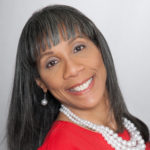PUBLISHED SEPTEMBER/OCTOBER 2020
An interview with Jalissa Corrie of Lee & Low Books and Christian romance author Pat Simmons.

Jalissa Corrie
Jalissa Corrie is a marketing and publicity manager at Lee & Low Books, the largest multicultural children’s book publisher in the United States.
How did concerns about racial inequity in publishing lead to the founding of Lee & Low?
Twenty-nine years ago, the co-founders of
Lee & Low Books, Tom Low and Philip Lee, noticed a void in the children’s book market. It wasn’t difficult to find books that featured white characters or to find books written and illustrated by white creators. But finding books that featured BIPOC (Black, Indigenous, People of Color) characters with BIPOC creators proved challenging. Why weren’t there more inclusive books? Where were books created by BIPOC? Where were books that featured BIPOC characters that moved beyond specific narratives like slavery and civil rights? Philip Lee and Tom Low started Lee & Low Books in 1991 with a vision: to publish books about everyone and for everyone.
What factors do you think account for the lack of BIPOC representation in publishing?
There are many different factors that account for the lack of BIPOC representation within publishing, including low entry-level salaries, which disproportionately affect BIPOC people, especially those who do not have the privilege of familial or spousal support. Publishing is central to New York City, one of the most expensive cities in the United States. Lack of opportunities outside of New York City are unfortunately few and far between. When we released the results of our
second Diversity Baseline Survey, we found that the demographic of interns surveyed were significantly more diverse than the industry as a whole. We can only speculate the reasons why, and I’m sure there are many, but I’d like to guess that more remote opportunities would help diversify publishing as seen in the survey.
Beyond socioeconomic barriers, BIPOC are up against systemic and institutional racism once we are in the publishing industry. Institutional racism manifests in different ways within publishing, such as comments like “How can a character be trans and Latinx?” or “We already have one of those books on our list, we don’t need another,” or “Black people don’t read, so this book won’t sell.” Unfortunately, biased comments like these happen more often than people may believe, and they remain unchecked and unchallenged, especially when they come from directors and management. When we do speak up, often we’re silenced, ignored, or dismissed, and concerns rarely ever result in some form of accountability from the offending party. There is a constant refusal to listen or examine the ways systemic racism permeates company culture, and this is the reality that BIPOC publishing professionals have to face every day.
What changes need to happen to address inequities in the publishing industry? What can publishers do to advance these changes?
To address inequities in publishing, first we have to acknowledge that racial inequity exists and that our industry is not exempt from institutional racism. Too many times, industry professionals have said that we’re doing well in regards to representation within the industry and among the books that are published. Though we’ve seen a recent shift in some areas, there is still so much work to do in regards to retention of BIPOC staff, in changing company culture and values, and in holding people accountable for racist and biased comments and actions. Our work is not over.
Listen to BIPOC publishing professionals when they speak. Believe BIPOC when we talk of our experiences and address concerns we may have. Challenge your assumptions and biases. Hire experts to lead discussions with your staff about inequity, systemic racism, and gatekeeping. Continual training will help professionals recognize when their biases are at play. Hire BIPOC professionals at managerial, directorial, and management levels. Look for candidates outside the publishing landscape to help contribute a fresh perspective. All in all, invest in inclusion and equity reform.
Any other thoughts to share concerning racial inequity in publishing?
There are no easy solutions to dismantling institutional racism, and racial equity will not be reached overnight. But every time we make a decision, we have the opportunity to either reinforce structural racism in publishing or chip away at it. It requires continuous work from everyone in publishing, from management to editorial to marketing to booksellers to readers. We can reach equity as long as we work toward the common goal of inclusion, when all voices are equally valued and heard.

Pat Simmons
Pat Simmons is a Christian romance author with more than 35 titles.
What has your publishing journey been like?
I started out traditionally published, and that gave me an open door. I’m a hybrid author. Some of my fellow authors, especially Blacks, feel publishers want our names on the roster, but not our stories. That is one of the main reasons why we are indie. For me, it is to maintain my voice, vision, and culture.
The benefit of being traditionally published is to have the additional marketing and editorial assistance. However, most white publishers don’t know how to market to our audience, so the expectation could be disappointing on both ends.
I’ve formed some great relationships with publishers, but if there are no Black editors on board, it can be exhausting explaining things.
What factors do you think account for the lack of BIPOC representation in publishing?
The short answer is: management. Where are the ethnic editors, marketing team, sales reps, agents, etc.?
What changes need to happen to address inequities in the publishing industry? What can publishers and/or authors do to advance these changes?
Add sensitivity proofreaders, readers, editors, etc. Consult with BIPOC organizations if management has questions about dialogue or scenes. Just because they don’t understand something, doesn’t mean it will be confusing to readers. Books should be educational and entertaining. I know it is exhausting for BIPOC authors, but we have to be diligent in the fight for every truth.
Any other thoughts to share concerning racial inequity in publishing?
Publishers need to do a better job of defining #ownvoices to their staff and other authors who aren’t BIPOC so they will have a clearer understanding of what diverse means. Adding a couple of BIPOC characters in the background, like Hallmark movies are known for, doesn’t make the story diverse. Publishers need to know #ownvoices means a story told by the experiences of BIPOC, not the majority. Simply having BIPOC authors on the roster doesn’t mean editors aren’t stifling their voices to dilute their culture to come off as more mainstream.
Here is a link to an article I wrote about the importance of Black characters.
For additional insight into BIPOC representation in book publishing, read the IBPA Independent articles tagged Diversity, Equity, & Inclusion.